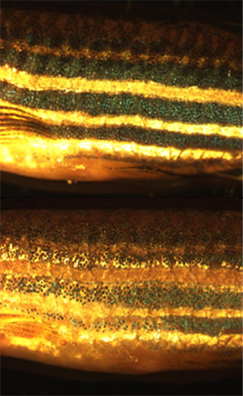Zebrafish
Zebrafish (Danio rerio) are a small tropical freshwater fish native to South Asia. They have become increasingly popular in scientific research over the past few decades, serving as an important model organism in studies related to genetics, developmental biology, toxicology, and neurobiology. Zebrafish are particularly valued in the scientific community for their transparent embryos, which allow researchers to observe developmental processes in real-time.
Description[edit | edit source]
Zebrafish are characterized by their distinctive horizontal stripes, which run along the length of their bodies. These stripes are caused by pigmented cells and serve as a form of camouflage in their natural habitat. Adult zebrafish typically reach about 2.5 to 4 cm in length. They are omnivorous, feeding on a variety of algae, zooplankton, and small insects.
Habitat[edit | edit source]
Originally found in the streams and rice paddies of the Ganges basin in India and Bangladesh, zebrafish have adapted to a wide range of environmental conditions. Their ability to thrive in both stagnant and flowing waters has contributed to their popularity as a model organism in laboratory settings.
Use in Research[edit | edit source]
Zebrafish embryos are nearly transparent, which allows researchers to easily study their development without invasive techniques. The genetic makeup of zebrafish is remarkably similar to that of humans, with many orthologous genes. This similarity has made them a valuable tool in understanding human genetic diseases, drug discovery, and toxicological testing. Zebrafish are also used in cancer research, where they can be used to study tumor growth and metastasis.
Genetic Manipulation[edit | edit source]
One of the reasons zebrafish are so valuable in research is their amenability to genetic manipulation. Techniques such as CRISPR/Cas9 and morpholino antisense oligonucleotides have been used to knock out or modify specific genes. This allows scientists to study the function of these genes during development and disease.
Conservation Status[edit | edit source]
Zebrafish are not currently considered endangered or threatened. Their wide distribution and adaptability to different environmental conditions have helped maintain stable populations in the wild. However, the impact of habitat destruction and pollution on local populations is not well documented.
In the Aquarium[edit | edit source]
Beyond their scientific utility, zebrafish are also popular in the aquarium hobby. They are prized for their vibrant colors and patterns, as well as their hardiness and ease of care. Zebrafish are social animals and do best in groups. They require a well-maintained tank with ample space to swim and a diet that mimics their natural omnivorous feeding habits.
Search WikiMD
Ad.Tired of being Overweight? Try W8MD's physician weight loss program.
Semaglutide (Ozempic / Wegovy and Tirzepatide (Mounjaro / Zepbound) available.
Advertise on WikiMD
|
WikiMD's Wellness Encyclopedia |
| Let Food Be Thy Medicine Medicine Thy Food - Hippocrates |
Translate this page: - East Asian
中文,
日本,
한국어,
South Asian
हिन्दी,
தமிழ்,
తెలుగు,
Urdu,
ಕನ್ನಡ,
Southeast Asian
Indonesian,
Vietnamese,
Thai,
မြန်မာဘာသာ,
বাংলা
European
español,
Deutsch,
français,
Greek,
português do Brasil,
polski,
română,
русский,
Nederlands,
norsk,
svenska,
suomi,
Italian
Middle Eastern & African
عربى,
Turkish,
Persian,
Hebrew,
Afrikaans,
isiZulu,
Kiswahili,
Other
Bulgarian,
Hungarian,
Czech,
Swedish,
മലയാളം,
मराठी,
ਪੰਜਾਬੀ,
ગુજરાતી,
Portuguese,
Ukrainian
Medical Disclaimer: WikiMD is not a substitute for professional medical advice. The information on WikiMD is provided as an information resource only, may be incorrect, outdated or misleading, and is not to be used or relied on for any diagnostic or treatment purposes. Please consult your health care provider before making any healthcare decisions or for guidance about a specific medical condition. WikiMD expressly disclaims responsibility, and shall have no liability, for any damages, loss, injury, or liability whatsoever suffered as a result of your reliance on the information contained in this site. By visiting this site you agree to the foregoing terms and conditions, which may from time to time be changed or supplemented by WikiMD. If you do not agree to the foregoing terms and conditions, you should not enter or use this site. See full disclaimer.
Credits:Most images are courtesy of Wikimedia commons, and templates, categories Wikipedia, licensed under CC BY SA or similar.
Contributors: Prab R. Tumpati, MD




